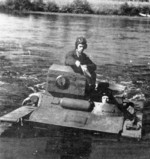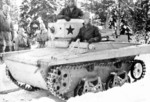T-37A
| Country | Russia |
| Manufacturer | No. 37 Plant, Moscow, Russia |
| Primary Role | Tankette |
Contributor: C. Peter Chen
ww2dbaseIn Feb 1932, the Soviet Union purchased British Vickers-Carden-Loyd Light Amphibious Tanks. After investigation, the British design inspired the T-37A design, which entered production in 1933, becoming the first mass-produced fully amphibious tanks in the world. Even though T-37A amphibious tanks were supposed to replace the older T-27 tankettes, the Soviet decision to keep both models in production at the No. 37 Plant named after N. Kozyrev in Moscow, Russia created problems, which were not equipped to maintain two distinct product lines. In the first half of 1933, only 30 examples were built (compared to the planned 255); in the second half of the year, 96 examples were built, which was still far below expectations. A change of management at No. 37 Plant in mid-1934, coupled with the start of T-37A production at the Izhorsky Plant in Leningrad, Russia and at subcontractor plants, finally increased production numbers, albeit at the cost of introducing wide variations between the vehicles produced at different locations. Production ceased in 1936 when the T-37A design was superseded by the T-38 design; between 1933 and 1936, about 1,200 examples were built. At the opening chapter of the European War, a large number of in-service T-37A amphibious tanks participated in the invasion of Poland, generally serving as reconnaissance vehicles and communications vehicles, and at times seeing combat as mobile machine gun platforms providing cover fire for advancing infantry. Many of them also served in Finland during the Winter War. They declined in numbers rapidly during the German invasion of 1941 as they were overrun by rapidly advancing German spearheads. As they had become obsolete by then, those surviving T-37A tanks were relegated to training and auxiliary defense roles in various parts of the Soviet Union.
ww2dbaseSource: Wikipedia
Last Major Revision: Jul 2015
T-37A Timeline
| 5 fev 1932 | British firm Vickers and Soviet organization All-Russian Co-operative Society (ARCOS) entered into an agreement for the Soviet military's purchase of eight British Vickers-Carden-Loyd Light Amphibious Tanks. |
SPECIFICATIONS
T-37A
| Machinery | GAZ-AA 3.3L 4cyl inline engine rated at 40hp |
| Suspension | Coil sprung bogie |
| Armament | 1x7.62mm DT machine gun (585 rounds) |
| Armor | 3-9mm |
| Crew | 2 |
| Length | 3.75 m |
| Width | 2.10 m |
| Height | 1.82 m |
| Weight | 3.2 t |
| Speed | 35 km/h |
| Range | 185 km |
Photographs
 |  |  |  |
Você gostou deste artigo ou achou este artigo útil? Se sim, considere nos apoiar no Patreon. Qualquer valor já vai ajudar! Obrigado. Por favor, ajude-nos a divulgar o site: Fique atualizado com WW2DB: |

- » Wreck of Teruzuki Found (27 jul 2025)
- » USS Orlean's Bow Found (22 jul 2025)
- » The Emperor of Japan Planned to Honor WW2-era Japanese POWs in Mongolia (4 jul 2025)
- » US State Lawmaker John Winter Caught Using Racial Slur "Jap" and Apologized (11 jun 2025)
- » US Government Plans to Purge WW2 Information (17 mar 2025)
- » Ver todas as notícias
- » 1,182 biografias
- » 337 eventos
- » 45,119 entradas na linha do tempo
- » 1,249 navios
- » 350 modelos de aeronaves
- » 207 modelos de veículos
- » 376 modelos de armas
- » 123 documentos históricos
- » 261 instalações
- » 470 resenhas de livros
- » 28,415 fotos
- » 365 mapas
Thomas Dodd, late 1945
Por favor, considere nos apoiar no Patreon. Mesmo R$1 por mês já faz uma grande diferença. Obrigado!
Ou, por favor, nos apoie adquirindo alguns produtos do WW2DB na TeeSpring. Obrigado!